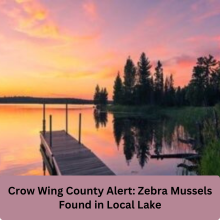
Zebra mussels have made headlines once again, this time in White Sand Lake, located in Crow Wing County, Minnesota. The Minnesota Department of Natural Resources (DNR) confirmed their presence after a local association reported finding them on a dock being removed for winter. This article dives deep into the implications of this discovery, how zebra mussels affect local ecosystems, and what you can do to prevent their spread.
Understanding Zebra Mussels
What Are Zebra Mussels?
Zebra mussels are small, striped freshwater mollusks that originate from the Caspian Sea region. They were introduced to North America in the 1980s and have since spread rapidly across many states.
The Lifecycle of Zebra Mussels
Zebra mussels reproduce at an alarming rate. A single female can produce up to one million eggs in a breeding season, leading to rapid population growth. Understanding their lifecycle is crucial for managing their spread.
Why Are Zebra Mussels a Concern?
Environmental Impact
Zebra mussels can cause significant harm to aquatic ecosystems. They filter out plankton, which affects the food chain, leading to a decline in fish populations. This can disrupt local fishing economies and recreational activities.
Economic Consequences
The presence of zebra mussels can lead to increased maintenance costs for property owners and local governments. They clog water intake pipes and can damage boats and docks, leading to costly repairs.
Recent Confirmations in Minnesota
White Sand Lake Findings
The recent confirmation of zebra mussels in White Sand Lake highlights a growing trend in Minnesota. Property owners and lake service providers frequently report finding these invasive species during dock removals at the end of the season.
Historical Context
This isn’t the first time zebra mussels have appeared in Minnesota lakes. Several new populations have been discovered in recent years, prompting the DNR to ramp up its invasive species management efforts.
What Should You Do If You Encounter Zebra Mussels?
Immediate Steps to Take
If you suspect zebra mussels in your area, contact the DNR immediately. They can provide guidance and support for managing the situation.
Prevention Measures
Preventing the spread of zebra mussels starts with individual responsibility. Here are some steps you can take:
1. Clean Your Equipment
Always clean your boat, trailer, and any water-related gear to remove aquatic plants and invasive species.
2. Drain All Water
Make sure to drain all water from your equipment and leave drain plugs out during transport.
3. Dispose of Bait Properly
Never release bait or aquarium pets into Minnesota waters. Dispose of unwanted bait in the trash.
Legal Requirements in Minnesota
Understanding the Law
Minnesota law mandates several actions to prevent the spread of invasive species. Here’s what you need to know:
1. Cleaning and Decontamination
It’s required to clean your watercraft and equipment thoroughly. This includes removing all aquatic plants and invasive species.
2. Drying Equipment
Keep docks and boat lifts out of the water for at least 21 days before moving them to another body of water.
Additional Decontamination Steps
The DNR recommends several additional steps to further reduce the risk of spreading zebra mussels:
1. Use High-Pressure Water
Spraying your equipment with high-pressure water can help dislodge any attached mussels.
2. Allow for Proper Drying
Let your watercraft and equipment dry for at least five days before using them in another water body.
Also read: 140 Fast-Food Restaurants Closing—Is Your Favorite at Risk?
Resources for Further Assistance
DNR Support
If you think you’ve encountered zebra mussels or any other invasive species, the DNR has resources available. Visit their website or contact an aquatic invasive species specialist for assistance.
Community Awareness
Engaging your local community is vital. Share information about zebra mussels and prevention strategies with fellow lake users to foster collective responsibility.
Conclusion: The Importance of Vigilance
The confirmation of zebra mussels in White Sand Lake serves as a crucial reminder of the ongoing battle against invasive species in Minnesota. By staying informed and taking proactive measures, we can protect our lakes and preserve their natural beauty for generations to come. It’s not just about our enjoyment; it’s about the health of our ecosystems and communities.
Also read: OpenAI’s ChatGPT Search: Google’s New Worst Nightmare
FAQs
How can I tell if my lake has zebra mussels?
Look for small, striped shells attached to docks, boats, or other surfaces. If you suspect they are present, contact the DNR for assistance.
What should I do if I find zebra mussels on my property?
Immediately report your findings to the DNR. They will provide guidance on how to handle the situation.
Are there any specific times when zebra mussels are more active?
Zebra mussels reproduce in warmer months, typically from late spring to early summer. However, they can survive year-round.
Can zebra mussels affect fishing in my lake?
Yes, they can disrupt the food chain, leading to a decline in fish populations, which can impact local fishing.
What are the penalties for not following Minnesota’s invasive species laws?
Violating these laws can result in fines and penalties. It’s crucial to follow all regulations to protect our waterways.
